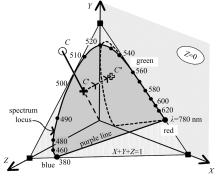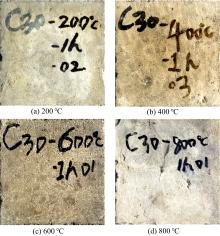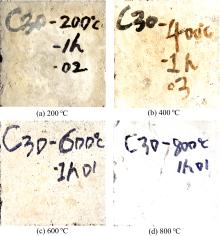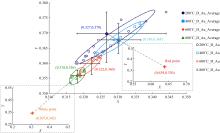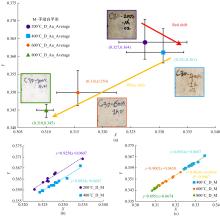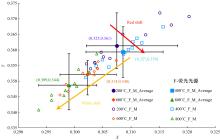Journal of Jilin University(Engineering and Technology Edition) ›› 2021, Vol. 51 ›› Issue (1): 233-244.doi: 10.13229/j.cnki.jdxbgxb20190937
Colorimetry method in assessing fire-damaged concrete
Ya WEI1( ),Wei-kang KONG2,Cheng WAN1,Yong-zhi ZUO3,Qiao-zhi LU3
),Wei-kang KONG2,Cheng WAN1,Yong-zhi ZUO3,Qiao-zhi LU3
- 1.Department of Civil Engineering,Tsinghua University,Beijing 100084,China
2.Shanxi Provincial Major Laboratory for Highway Bridge and Tunnel,Chang′an University,Xi′an 710064,China
3.Beijing Building Construction Research Institute,Beijing 100039,China
CLC Number:
- TB321
| 1 | Vejmelková E, Koňáková D, Scheinherrová L, et al. High temperature durability of fiber reinforced high alumina cement composites[J]. Construction and Building Materials, 2018, 162: 881-891. |
| 2 | Zhang Q, Ye G. Dehydration kinetics of Portland cement paste at high temperature[J]. Journal of Thermal Analysis and Calorimetry, 2012, 110(1): 153-158. |
| 3 | Sabeur H, Platret G, Vincent J. Composition and microstructural changes in an aged cement pastes upon two heating-cooling regimes, as studied by thermal analysis and X-ray diffraction[J]. Journal of Thermal Analysis and Calorimetry, 2016, 126: 1023-1043. |
| 4 | Collier N C. Transition and decomposition temperatures of cement phase―a collection of thermal analysis data points[J]. Ceramics-Silikáty, 2016, 60(4): 338343. |
| 5 | Schneider U. CIB W14 Report, reparability of fire damaged structures[J]. Fire Safety Journal, 1990, 16: 251-336. |
| 6 | Kim K Y, Yun T S, Park P K. Evaluation of pore structures and cracking in cement paste exposed to elevated temperatures by X-ray computed tomography[J]. Cement and Concrete Research, 2013, 50: 34-40. |
| 7 | Li Z H, Wong L N Y, Teh C I. Low cost colorimetry for assessment of fire damage in rock[J]. Engineering Geology, 2017, 228, 50-60. |
| 8 | 陈明阳, 侯晓萌, 郑文忠, 等. 混凝土高温爆裂临界温度和防爆裂纤维掺量研究综述与分析[J]. 建筑结构学报, 2017, 38(1): 161-170. |
| Chen Ming-yang, Hou Xiao-meng, Zheng Wen-zhong, et al. Review and analysis on spalling critical temperature of concrete and fibers dosage to prevent spalling at elevated temperatures[J]. Journal of Building Structures, 2017, 38(1): 161-170. | |
| 9 | 郑文忠, 侯晓萌, 王英. 混凝土及预应力混凝土结构抗火研究现状与展望[J]. 哈尔滨工业大学学报, 2016, 48(12): 1-18. |
| Zheng Wen-zhong, Hou Xiao-meng, Wang Ying. Progress and prospect of fire resistance of reinforced concrete and prestressed concrete structures[J]. Journal of Harbin Institute of Technology, 2016, 48(12): 1-18. | |
| 10 | Zheng W Z, Hou X M, Shi D S, et al. Experimental study on concrete spalling in prestressed slabs subjected to fire[J]. Fire Safety Journal, 2010, 45(5): 283-297. |
| 11 | Osumi A, Enomoto M, Ito Y. Basic study of an estimation method for fire damage within concrete sample using high-intensity ultrasonic waves and optical equipment[J]. Japanese Journal of Applied Physics, 2014, 53(7S): 07KC16. |
| 12 | Yang Y. Evaluating temperature distribution of the sections of fire damaged concrete elements by ultrasonic pulse method[J]. Journal of Southwest Jiaotong University, 1993. |
| 13 | Shin S W, Kim S Y, Kim J S. Applicability of impact-echo method for assessment of residual strength of fire-damaged concrete[J]. Journal of Metals Materials and Minerals, 2013, 23(1): 105-112. |
| 14 | Du H X, Zhang X, Han J H. Testing and evaluating damage of concrete exposed to fire by infrared thermal image[J]. Journal of Tongji University, 2002(9);1078-1082. |
| 15 | Felicetti R. The drilling resistance test for the assessment of fire damaged concrete[J]. Cement and Concrete Composites, 2006, 28(4): 321-329. |
| 16 | Felicetti R. Digital camera colorimetry for the assessment of fire damaged concrete[C]∥ Proceedings of the Workshop on Fire Design of Concrete Structures: What now?What next?, Milan, Italy,2004:211-220. |
| 17 | Colombo M, Felicetti R. New NDT techniques for the assessment of fire-damaged concrete structures[J]. Fire Safety Journal, 2007, 42(6/7): 461-472. |
| 18 | Hager I. Colour change in heated concrete[J]. Fire Technology, 2014, 50(4): 945-958. |
| 19 | Ashby M F, Ferreira P J, Schodek D L. Nanomaterials, Nanotechnologies and Design: An Introduction for Engineers and Architects[M]. London:Butterworth-Heinemann, 2009. |
| 20 | Ashby M F, Shercliff H, Cebon D. Materials: Engineering, Science, Processing and Design(Third ed)[M]. London:Butterworth-Heinemann, 2013. |
| 21 | Bessey G E. Investigations on building fires, part2:the visible changes in concrete or mortar exposed to high temperatures[M]//National Building Studies Technical Paper 4, London: HMSO Publishing, 1950: 6-18. |
| 22 | Ingham J P. Application of petrographic examination techniques to the assessment of fire-damaged concrete and masonry structures[J]. Materials Characterization, 2009, 60(7): 700-709. |
| 23 | Carré H, Hager I, Perlot C. Contribution to the development of colorimetry as a method for the assessment of fire-damaged concrete[J]. European Journal of Environmental and Civil Engineering, 2014, 18(10): 1130-1144. |
| 24 | Oestmo S. Digital imaging technology and experimental archeology: a methodological framework for the identification and interpretation of fire modified rock(FMR)[J]. Journal of Archaeological Science, 2013, 40(12): 4429-4443. |
| 25 | Felicetti R. Assessment methods of fire damages in concrete tunnel linings[J]. Fire Technology, 2013, 49(2): 509-529. |
| 26 | Gómez-Robledo L, López-Ruiz N, Melgosa M, et al. Using the mobile phone as Munsell soil-colour sensor: an experiment under controlled illumination conditions[J]. Computers and Electronics in Agriculture, 2013, 99: 200-208. |
| 27 | Annarel E, Taerwe L. Methods to quantify the colour development of concrete exposed to fire[J]. Construction and Building Materials, 2011, 25(10): 3989-3997. |
| 28 | Annarel E, Taerwe L. Revealing the temperature history in concrete after fire exposure by microscopic analysis[J]. Cement and Concrete Research, 2009, 39(12): 1239-1249. |
| 29 | Short N R, Purkiss J A, Guise S E. Assessment of fire damaged concrete using colour image analysis[J]. Construction and Building Materials, 2001, 15(1): 9-15. |
| 30 | Short N R, Purkiss J A, Guise S E. Assessment of fire-damaged concrete using crack density measurements[J]. Structural Concrete, 2002, 3(3): 137-143. |
| 31 | Cowan W B. An inexpensive scheme for calibration of a colour monitor in terms of CIE standard coordinates[J]. ACM SIGGRAPH Computer Graphics, 1983, 17(3): 315-321. |
| 32 | 公安部消防局. 2018中国消防年鉴[M]. 云南: 云南人民出版社, 2018. |
| 33 | Midgley H G. The use of thermal analysis methods in assessing the quality of high alumina cement concrete[J]. Journal of Thermal Analysis, 1978, 13(3): 515-524. |
| 34 | Raina S J, Vishwanathan V N, Ghosh S N. Instrumental techniques for investigation of damaged concrete[J]. Indian Concrete Journal, 1978, 52(5/6):147-149. |
| [1] |
ZHANG Pei-ping, WANG Li-dan,ZHANG Li-gong, LUO Jin-song2, FAN Yi .
Preparation and properties of Nd/Si codoped YAG powders [J]. 吉林大学学报(工学版), 2009, 39(02): 354-0357. |
|
||


